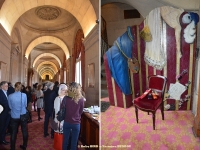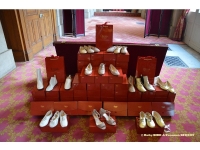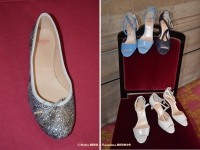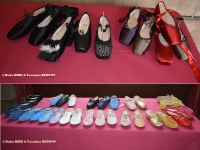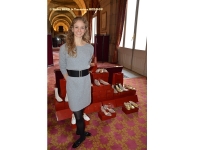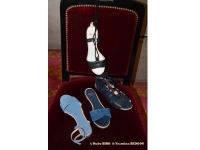Entertainment
OPERA NATIONAL DE PARIS introduces its New Shoes Collections 2016-2017
With Muse LEONORE BAULAC
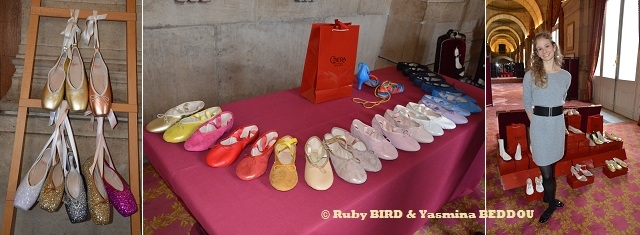
(R) The MUSE Léonore BAULAC (Source: © Ruby BIRD & Yasmina BEDDOU)
USPA NEWS -
On November 9, 2016 were presented the 'New Shoes Collection - Christmas 2016 & Summer 2017' at the OPERA GARNIER in PARIS. Created by the architect Charles Garnier in 1875, the PALAIS GARNIER houses a prestigious auditorium and public areas (grand foyer, rotonde des abonnés, salons),...
On November 9, 2016 were presented the 'New Shoes Collection - Christmas 2016 & Summer 2017' at the OPERA GARNIER in PARIS. Created by the architect Charles Garnier in 1875, the PALAIS GARNIER houses a prestigious auditorium and public areas (grand foyer, rotonde des abonnés, salons), a museum-library, as well as several rehearsal studios and workshops. The 'Italian-style' auditorium, with its ceiling painted in 1964 by Marc Chagall, can accommodate 2054 spectators. With nearly 480,000 visitors each year, it is one of Paris' most visited monuments. It has been listed as a historical monument since 1923.
In 1661, founding of the Académie royale de Danse (Royal Academy of Dance) by Louis XIV with the purpose of training dancers and formalising choreographic art. In 1669, founding of the Académie royale de Musique (Royal Academy of Music), also known as Académie d'Opéra or Opéra, at the instigation of Colbert. Under the aegis of the crown, this institution brought together a group of singers, the first professional orchestra in France and the Ballet Company of the Académie royale de Danse in order to promote French opera in Paris and in the more important cities in the kingdom.
During the two centuries that followed its creation, the Opéra changed its venue eleven times: it resided at la Bouteille (1670-1672), the Jeu de Paume(1672-1673), the Palais-Royal (1673-1763), the Salle des Machines (1764-1770), the second hall of the Palais-Royal (1770-1781), the Menus-Plaisirs (1781), the Porte Saint-Martin (1781-1794), the Salle de la Rue de Richelieu (1794-1820), the Théâtre Louvois (1820), the Salles Favart (1820-1821) and Le Peletier (1821-1873).
In 1681, The Ballet of the Opéra opened its doors to women dancers for the first time. In 1776, Jean-Georges Noverre, now considered to be the founder of modern ballet, introduced ballet d'action to the stage of the Opera: for the first time the corps de ballet was to dance, not merely an interlude, but a narrative ballet in which the story was developed through dance and pantomime. In 1784, the king endowed the Opéra with a Ballet School, previously the existing École de l'Académie.
In 1939, the French government decided to merge the Opéra Comique, now in financial difficulties, with the Théâtre National de l'Opéra to form the Réunion des Théâtres Lyriques Nationaux (Union of National Operatic Theatres). The Opéra Comique did not regain its independence until 1990. In 1974, creation of the Opéra Studio, a training centre for opera singers at the Salle Favart. It was to be replaced by the Atelier Lyrique (Operatic Workshop) in 2005. In 1982, Judging the scope of the Palais Garnier to be insufficient, President François Mitterand decided to build a new, modern opera house in Paris. A competition was organised for which 1700 architects entered a total of 756 projects.
In 1988, Pierre Bergé, the co-founder and president of the haute couture company Yves Saint-Laurent, became head of the board of directors of the Opéra. He was to organise the inauguration ceremony of the Opéra Bastille. July 13, 1989, inauguration of the Opéra Bastille as part of the bicentenary celebrations of the French Revolution. In 1990, The Palais Garnier and the Opera Bastille merge to form the Opéra de Paris. In 1994, The Paris Opéra became the Opéra National de Paris. The change of name indicated its intention to extend its scope beyond the confines of the capital.
In 2014, after serving as Company Secretary at the Théâtre d'Aubervilliers, co-director at the Centre Dramatique national de Nice and the Théâtre des Bouffes du Nord, director of the Théâtre du Châtelet, general manager of the Orchestre de Paris, director of the Festival International d'Aix-en-Provence and then general manager and artistic director of Milan's Teatro alla Scala, Stéphane Lissner became director of the Opéra national de Paris.
- About The MUSE Léonore BAULAC
Born in 1990 in Paris, she is French-Norwegian. Actually, she is First Danser in the Ballet de l´Opéra national de Paris. For this Shoes collections, Christmas 2016 and Summer 2017, was chosen as MUSE. She entered the Opéra de Paris School in 2005. In 2008, she is engaged in the Corps de ballet. In 2014, she is awarded the 'Coryphée'.
Born in 1990 in Paris, she is French-Norwegian. Actually, she is First Danser in the Ballet de l´Opéra national de Paris. For this Shoes collections, Christmas 2016 and Summer 2017, was chosen as MUSE. She entered the Opéra de Paris School in 2005. In 2008, she is engaged in the Corps de ballet. In 2014, she is awarded the 'Coryphée'.
- OPERA DE PARIS Shoes - Winter 2016/2017 : description
* Boots
* Ballerines à Rubans (Ballerinas with ribbons)
* Demi-pointes (Half Spikes)
* Pointes (Spikes)
* Pointes en Satin (Spikes in Satin)
- OPERA DE PARIS - Summer 2017 : description
* Half Spikes with Monochrome Elastic
* Cyclist
* New soft Spikes
* Naked foot, Sewn Returned
* Heels
* Nude, White and Gold, Boots, Cyclists, Ballerinas
Source : Opéra National de Paris - November 8, 2016
Ruby BIRD
http://www.portfolio.uspa24.com/
Yasmina BEDDOU
http://www.yasmina-beddou.uspa24.com/
* Boots
* Ballerines à Rubans (Ballerinas with ribbons)
* Demi-pointes (Half Spikes)
* Pointes (Spikes)
* Pointes en Satin (Spikes in Satin)
- OPERA DE PARIS - Summer 2017 : description
* Half Spikes with Monochrome Elastic
* Cyclist
* New soft Spikes
* Naked foot, Sewn Returned
* Heels
* Nude, White and Gold, Boots, Cyclists, Ballerinas
Source : Opéra National de Paris - November 8, 2016
Ruby BIRD
http://www.portfolio.uspa24.com/
Yasmina BEDDOU
http://www.yasmina-beddou.uspa24.com/
Liability for this article lies with the author, who also holds the copyright. Editorial content from USPA may be quoted on other websites as long as the quote comprises no more than 5% of the entire text, is marked as such and the source is named (via hyperlink).

